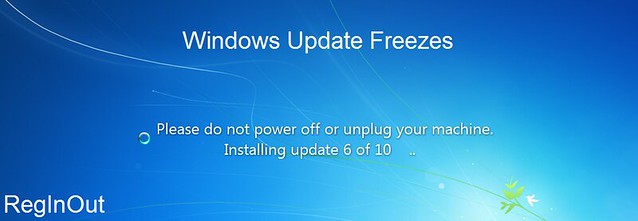Included page "clone:alisha" does not exist (create it now)
Windows Update Freezes - 17 Jul 2013 07:01
Tags: - freezes stuck update windows
Windows Update is a great tool to make sure your computer is up-to-date with latest patches and updates. It offers exciting updates to fix problems concerning with various objects.
Most of the time, the tool does its job without much user attention. However many people have come across Windows Update freezes. The main problem is that the tool hangs or freezes in middle. That in fact, takes a little longer time than expected. If you’re encountering the same problem, here are the solutions outlined for you:
1. Update BIOS
2. Stop Services
3. Run Windows Update Troubleshooter
4. Delete Corrupt Downloader Files
5. Restart Windows Update Services
6. Restore the System
Tip: To Avoid Windows Freezing Download Fix-it Wizard
Update BIOS
An outdated BIOS can cause Windows Update freezes. Since the BIOS is involved with system board and other hardware, you should have the latest version installed.
1. Click the Start button.
2. Type “MSINFO32” in the Search box.
3. Press ENTER.
4. System Information program opens.
5. Under System Summary, the BIOS Version appears. Note it down for future reference.
6. Visit the website of your computer manufacturer, download the latest BIOS version and install it.
Stop Services
Non-Microsoft services such as error reporting tools, scheduled tasks may cause Windows Update freezes. Since they lead Higher CPU usage, your operating system gets little amount of memory for performing Windows Update. Stop the unnecessary services by following the steps given below:
1. Download RegInOut System Utilities.
2. Install and run the program.
3. Click the Optimize button under Optimize Services.
4. Select a new profile and confirm your action.
Run Windows Update Troubleshooter
Windows Update Troubleshooter is a program designed by Microsoft to diagnose problems with the update utility. It is a kind of automatic fix-it utility. Open Windows Update Troubleshooter as shown here:
1. Click Start | Control Panel.
2. Press F3 key and type “Troubleshooter” in the Search box.
3. Click Troubleshooting | System and Security.
4. Click Windows Update.
5. The Troubleshooter program will detect and fix problems.
Delete Corrupt Downloader Files
The update downloader files are located in the Network Downloader folder. Corrupt file contents lead update lags issue. Run the Command Prompt and delete the files as shown below:
1. Click the Start button, point to All Programs | Accessories. Right click Command Prompt, select Run as Administrator.
2. Type following command-
%ALLUSERSPROFILE%\Application Data\Microsoft\Network\Downloader\qmgr*.dat
EXIT
Restart Windows Update Services
Windows Update services might need to be restarted. Stop and re-start the services again to prevent update lags.
1. Open Command Prompt.
2. Type following commands-
net start bits
net start wuauserv
EXIT
Restore the System
If the update lagging problem still occurs, restore your system to an earlier date. Here are the steps to do so:
1. Click the Start button.
2. Point to All Programs | Accessories | System Tools | System Restore.
3. Click Next, select a system restore point and confirm. - Comments: 0
Windows 8 Driver Updates -- Find Missing Drivers - 12 Jul 2013 10:12
Tags: - 8 driver issue missing problem update updates windows
Windows 8 driver update problem is so common in the Consumer Preview edition. Majority of users complain audio driver issue. This article would guide you how to update drivers in Windows 8. It contains troubleshooting steps that are helpful for resolving driver update issue.
Below are outlined some important steps through which you can update Windows 8 Drivers without any hassle.
Steps to Update Drivers in Windows 8:
· Update Drivers in Windows 8
· Change Windows 8 Settings
· Modify/ Repair Windows 8 Registry
· Set Audio Service to Automatic
Tip: Update Windows 8 Drivers Automatically Here
Update Drivers in Windows 8
Many users are complaining they are having problem with their audio driver in Windows 8. So, we shall focus sound driver and rest of the drivers can be updated similarly. If you are experiencing problem with your Sound Driver, you need to follow the procedure given below:
1. First of all check your Sound Card Name and Model Number.
2. Download Windows 8 compatible drivers from the manufacturer’s website.
3. Install latest driver by following the on-screen instructions.
4. Restart Windows 8.
Change Windows 8 Settings
If you are still encountering sound problem after updating your sound driver, change Windows 8 settings given below. Here are simple steps through which you can change Windows 8 Settings:
1. Close all open programs. Click Settings in the metro interface.
2. Select Show Administrative Tools. Look for your Sound Card Name.
3. Click on icon for Configuration.
4. Click on Speaker. Click on Turn OFF 7.1 Settings.
5. Restart Windows 8.
Modify/ Repair Windows 8 Registry
If you are still having issues with your sound in Windows 8, the best thing to do is changing Registry settings. Follow the steps written below:
1. Close all active programs.
2. Open Command Prompt in Windows 8 and input “REGEDIT” without quotes.
3. In the Registry Editor search for AUDIOSRV (you can do that by pressing CTRL + F).
4. Now edit “requiredprivileges”.
5. Delete data from REQUIREDPRIVILEGES.
6. Close Registry Editor. Sound should work fine.
Note: Registry is a key component of Windows operating system. It needs maintenance on a regular basis. Hence it is recommended to use Windows 8 Registry Cleaner to fix the problem.
Set Audio Service to Automatic
It could be a reason that the most important audio service is stopped. Re-start it in order to fix Windows 8 Driver Updates error.
1. In Windows 8, open Settings through Metro Interface.
2. In Settings, type “Services” (without quotes). Now right-click on Windows 8 Audio service and select Properties.
3. Set Startup Type=> Automatic.
4. Click the Start button to immediately start the service.
5. Restart Windows 8. - Comments: 0







